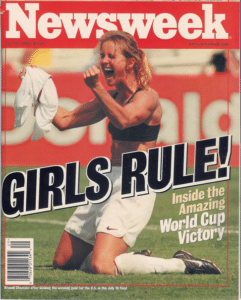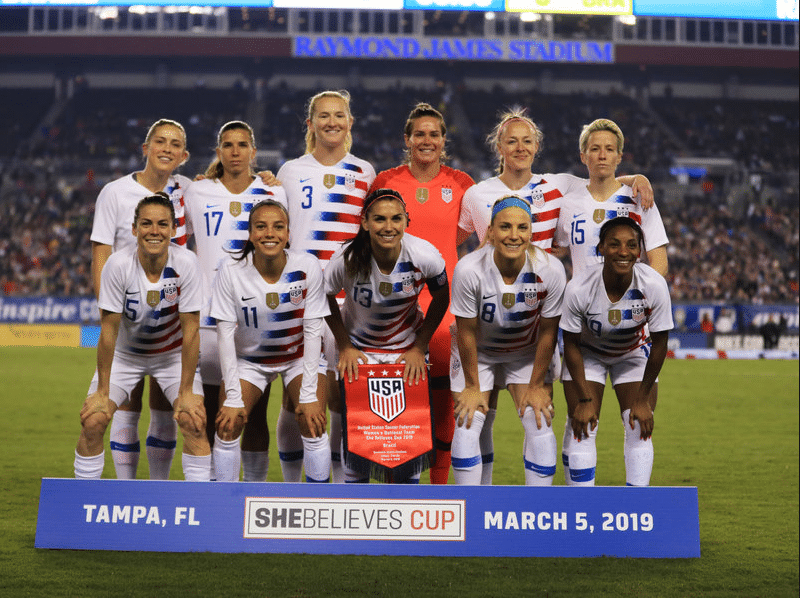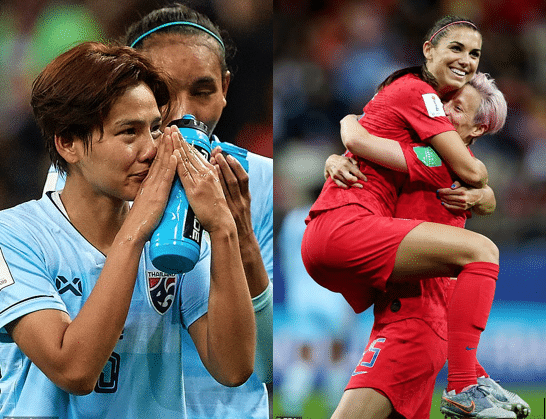The media covered so much promotional hype for the 2018 FIFA Men’s World Cup in Russia that, by the time play got under way, the matches seemed anticlimactic. By contrast, the media covered so little of the same for this 2019 FIFA Women’s World Cup in France that most people probably had no idea when play was scheduled to get under way. Waking up to Friday’s Google Doodle was probably their first clue.
Furthermore, the sports section of every American news broadcast or site won’t even lead off today with the latest results from this World Cup. Instead, adding insult to oversight, they will lead off with those from some other men’s sporting event. I’d bet my life savings on that. I’m on record decrying this unequal coverage in “Sexism Explains Media Disinterest in Women’s World Cup,” June 12, 2015.
Of course, unequal coverage of women’s sports is not limited to soccer. I have been decrying this discrepancy for years, beginning with “NCAA Women’s Basketball Championship,” April 8, 2009.
In fact, track and field, swimming, gymnastics, and beach volleyball are the only sports where women’s events get similar media coverage. Unfortunately, that coverage is relatively little – except when the media rediscovers the popularity of these sports every four years at the Olympics.
The point is that, except for these major international tournaments, media coverage of women’s soccer pale in comparison to that of other sports like men’s basketball, football (soccer too), and baseball (cricket too).
 To be fair, though, the media are not entirely to blame. After all, I’m old enough to remember the expectations Team USA winning the 1999 World Cup generated. Members of that team were even suggesting that year-round interest in and coverage of women’s soccer would soon rival those of the men’s sports mentioned above.
To be fair, though, the media are not entirely to blame. After all, I’m old enough to remember the expectations Team USA winning the 1999 World Cup generated. Members of that team were even suggesting that year-round interest in and coverage of women’s soccer would soon rival those of the men’s sports mentioned above.
That turned out to be a pipe dream. Because, outside Olympic and World Cup tournaments, interest waned and coverage drained. And so the bane of women’s soccer remained unequal pay. This explains why members of Team USA finally sued their federation to get fair pay and benefits in comparison to their male counterparts.
They were forced to this extreme even after winning their third World Cup title in 2015. An indignity made all the more resentful considering that their male counterparts have never even made it to the final match. The men even failed to qualify for the 2018 World Cup.
Notwithstanding all that, here in part is how I commented on their lawsuit in “Women Soccer Players in the Match of their Lives,” November 22, 2016:
____________________
Despite their achievements, the players say they have been discriminated against, paid less and treated worse, next to the U.S. men’s team. Soccer may be known as the beautiful game, but the team has embarked on a bruising and historic legal fight for equality and their opponent is the U.S. Soccer Federation, their own employer.
(CBS 60 Minutes, November 20, 2016)
This pay dispute transcends sports. What’s more, it’s complicated, not least because it’s not the typical apples-to-apples case of women doing the same work as men, in the same workplace, for less pay.
 Foremost, women soccer players do not generate as much interest, let alone as much revenue, as their male counterparts. Which is why this is not just about discrimination – as the women players claim. It’s also about capitalism. …
Foremost, women soccer players do not generate as much interest, let alone as much revenue, as their male counterparts. Which is why this is not just about discrimination – as the women players claim. It’s also about capitalism. …
Indeed, nothing undermines their claims quite like women tennis players getting equal pay because they generate as much interest and revenue as their male counterparts. What’s more, women golf, soccer, and basketball players help make the case for unequal pay. For, like hockey players, they do not get equal pay because they do not generate as much interest and revenue as the men in their sports, respectively. …
All the same, I urge you to not only watch this soccer match for equal pay as it plays out, but cheer for the women players against the federation – as if they were playing a final World Cup match against the Russians. Because they deserve all of the money they can get … even if it’s not equal to what their male counterparts are getting.
____________________
Believe it or not, equal pay and benefits remain so elusive that members of Team USA are participating in this World Cup under protest. This, despite signing a collective bargaining agreement last year that was supposed to increase pay, benefits, and per diems equal to those of the men’s team.
A federal lawsuit by 28 members of the team alleging gender discrimination by U.S. Soccer is the latest dispute over pay for the USWNT. …
According to the complaint, despite greater success than the U.S. men’s national team, the women’s team has consistently been paid drastically less. The women won the 2015 World Cup and shared a bonus of $1.73 million; the men lost in the Round of 16 in the 2014 World Cup and split $5.38 million in performance bonuses.
(The Washington Post, March 12, 2019)
No doubt the women hope defending their 2015 title will bolster their case. But even if they flame out in the Group Phase, they would still have a convincing case for pay and benefits on par with their male counterparts.
Which obliges me to share that feedback from my 2016 commentary quoted above was such that it warrants this clarification: I distinguish between pay and benefits for professional league play (e.g., in Europe, where teams generate revenues of $28 billion annually — more than America’s National Football League, National Hockey League, and Major League Baseball combined) and national team play (e.g., for international tournaments like the World Cup and Olympics).
Because, no matter how much men duly earn playing for their respective professional teams, they should earn no more than women when they too are playing for their respective national teams. For surely, regarding the latter, national pride should be the primary motivating factor.
This is why women players have just cause to complain about the winning team for the men’s 2018 World Cup getting $38 million; whereas the winning team for the women’s 2019 World Cup is getting only $4 million.
Alas, this suggests that misogynists are still governing international soccer. The scandals they caused were supposed to compel reforms. I duly commented in “FIFA – Soccer’s Federation of Imbeciles, Fraudsters, and Autocrats,” May 29, 2015, and “Soccer Shocker: Blatter Resigns,” June 3, 2015.
That said, as much as I’m rooting for them in court, I won’t be rooting for the women of Team USA on the field. I am a perennial cheerleader for the underdog; therefore, I’m rooting for Brazil.
 Besides, I’d like to see its star player Marta finally win. To appreciate this shortcoming, just imagine if, at this point in his career, LeBron James had yet to win a single NBA championship. (He has won 3.) Such is the pressure on Marta to win in this her fifth and probably final World Cup.
Besides, I’d like to see its star player Marta finally win. To appreciate this shortcoming, just imagine if, at this point in his career, LeBron James had yet to win a single NBA championship. (He has won 3.) Such is the pressure on Marta to win in this her fifth and probably final World Cup.
Brazil got off to a promising start yesterday with a 3-0 drubbing of quadrennial gamer Jamaica (a.k.a. the Reggae Girlz). This, despite Marta sitting out with an injury she suffered in practice two weeks ago.
Brazil’s coach and team manager reassured the press that they benched her only out of an abundance of caution. They want to ensure that she’s fully recovered for forthcoming matches, which will be far more challenging and critical for advancing beyond the Group Phase.
But I’d be remiss not to note that, unlike the Jamaican men’s bobsledding team of Cool Runnings fame, at least this Jamaican women’s soccer team is a legitimate participant in this World Cup. It’s the first team (men or women) from the Caribbean to make it through the qualifying rounds. Never mind the inconvenient truth that the majority of its members were born in the USA …
Goooooooooo Brazil!
Related commentaries:
World Cup Russia…
Sexism explains media disinterest…
NCAA women’s…
Match of their lives…
FIFA corruption…
Soccer shocker…
Cool runnings…
Update
Team USA looks invincible
June 11
The United States posted its biggest victory ever at the World Cup on Tuesday, opening the defense of its 2015 title with a 13-0 annihilation of overmatched Thailand in Reims, France.
It was the largest margin of victory ever at the World Cup, and the most goals scored in a single World Cup match. The Americans outshot Thailand, 39-2.
(The New York Times, June 11, 2019)
Frankly, this match should trigger calls for a mercy rule. It should require any team with a 5-goal lead to play only defense until the opposing team scores. In other words, no team with a 5-goal lead should be allowed to take shots on goal.
Truth be told, Team USA looked like 11 Martas toying with high-school players. But I doubt they’ll be able to toy with my team, Brazil, and its real Marta like this.
Even worse, though, Team USA added shame to their blowout by celebrating like they had just won the Cup itself. Its members should bank that feeling because they might have just jinxed their presumed destiny to celebrate after winning the real thing.
Whether it’s karma, comeuppance, or just deserts, that celebration smacked of begging for it.


